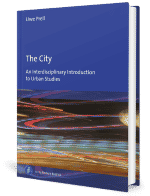 New with Budrich:
New with Budrich:
The City. An Interdisciplinary Introduction to Urban Studies
by Uwe Prell
About the book
The City presents the current state of urban research across various disciplines. The author offers insights into the views of those key disciplines that deal with urbanism, such as sociology, geography, spatial and urban planning, history, philosophy, and political science. He also takes language philosophy into account and shows the different meanings of concepts related to cities in a dozen word languages. An overview of central approaches and theories as well as of their practical application enables readers to see a familiar topic in a new light.
Dear Uwe Prell, what is your book “The City” about?
The book attempts a general overview. Urban research is carried out by more than a dozen disciplines. Unfortunately, it is still too seldom possible to link the findings with each other. The idea of the book is to find a new path in this direction.
In 2020, you first published the book in German under the title “Die Stadt”. Did you adapt the content of the English book? Have any questions or topics been added?
The book is a translation. The sources are adapted to English-language literature. German literature and texts in other languages have been cited only when they offer a particular contribution.
At the moment we are experiencing a paradigm shift in urban studies. It is driven mainly by historians who offer new insights into the origins of urbanism. My book already hints at this, and my core theses correspond with the new interpretations.
What target groups did you have in mind when you developed the concept for the book? Who should read it?
The book is aimed at beginners without prior knowledge. Anyone dealing with the subject for the first time should get a compact, easy-to-read and inspiring overview. And that in theory and practice. Theory without practice often remains anaemic. But for a convincing practice, there is nothing more practical than a good theory.
I have also tried to integrate the emotional dimensions. In science, they often come up short. That is why the research often seems dry and uninspiring.
But cities are fascinating because of their appearance, their people, their vitality; they have their own topography, their own flair, their own light, and their own smell. It is important to me that all this is perceived as an elementary component. Since such perceptions are often also subjective, they are labelled as just that. I hope that this will stimulate – in one or two cases it may also excite – and perhaps it will also encourage people to laugh.
Your book takes an interdisciplinary approach. What challenges does interdisciplinary urban research have to contend with?
It takes an infinitely long time. I am a political scientist and historian. I had to familiarize myself intensively with the other subjects, i.e. understand their methodological and theoretical foundations as well as their empirical-analytical findings, at least in outline. That simply takes a lot of time.
Why should the city in particular be researched in an interdisciplinary approach?
Because it cannot be understood any other way. The disciplines have been creating puzzle pieces since Aristotle and systematically for about a century. But a complete picture has not emerged yet. At times I even have the impression that the hoped-for picture is blurring again. My book is a suggestion how such a picture – at least as a sketch – could look like.
Short vita in own words
 I studied political science at Freie Universität with Prof. Helga Haftendorn, one of the best experts on German foreign policy and transatlantic relations in the 1980s. After that, I worked for the Berlin Senate for several years. This was followed by a number of Berlin studies – all empirical analysis on specific topics, such as the Soviet blockade of Berlin in 1948/49. On behalf of the Senate, I was then one of the two editors who produced the first comprehensive urban encyclopedia, the Berlin Handbook.
I studied political science at Freie Universität with Prof. Helga Haftendorn, one of the best experts on German foreign policy and transatlantic relations in the 1980s. After that, I worked for the Berlin Senate for several years. This was followed by a number of Berlin studies – all empirical analysis on specific topics, such as the Soviet blockade of Berlin in 1948/49. On behalf of the Senate, I was then one of the two editors who produced the first comprehensive urban encyclopedia, the Berlin Handbook.
Afterwards I changed professionally into the economy and compiled parallel my dissertation. It attempts a systematic, scientific overall presentation of the city of Berlin. City portraits throughout the same tradition, describing first the geographic area, then the beginnings and further history up to current politics, furthermore economy, culture and society. In my work, I have tried to develop a social science-based method, the density description, to give such attempts more stringency and commitment. This was a first big step from empiricism to theory. Usually, academic research paths run exactly the other way around. In the meantime, I have devoted myself entirely to theory and basic research, which is, however, always anchored in practice. This is how my “Theory of the City in Modernity” came about, with which I completed my habilitation at the TU Chemnitz. The current book compactly summarizes the findings of the last three decades. At the same time it opens the door for a next big project, the attempt to locate the city in International Relations.

Order now via our web shop:
The City. An Interdisciplinary Introduction to Urban Studies
by Uwe Prell

